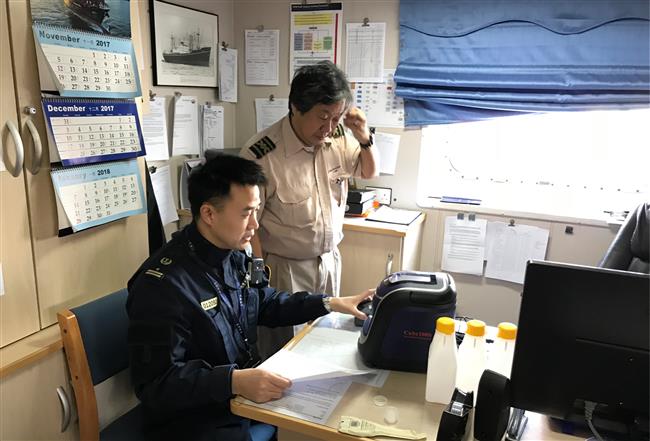Sulfur content in ship fuel now detected faster

With the help of a new facility, the maritime authority can now detect the amount of sulfur in ship fuel in about 130 seconds.
Shanghai maritime authority applies new facility which can detect the amount of sulfur in ship fuel in about two minutes instead of the previous three days.
To contribute to a better air quality, all vessels entering or berthing at Shanghai’s ports are required to use low-sulfur fuel to cut emission since last year.
But the procedure of specifying the amount of sulfur in ship fuel takes about three days, which affects the efficiency of port operation. Also, a vessel might have already left the port before a test report is released.
A new portable device has been put into use by Shanghai Maritime Bureau’s law enforcement team this week to test the fuel samples of vessels.
In an inspection over a Singapore-registered boat “Shengking” on Wednesday morning, law enforcement team staff took 5 milliliters of fuel sample from the boat. With the new facility, a primary report was produced after 130 seconds, showing that the fuel sample met the standard of less than 0.5 percent.
According to maritime authority, reports by the new device can be used as reference in daily inspection to raise work efficiency. However, to place punishments to regulation violators, a detailed laboratory report is still required.
According to a report by the local environmental authority in 2013, boats and ships operating in Shanghai accounted for 12.4 percent all discharges of air pollutant sulfur dioxide.
To improve the situation, vessels entering or berthing in Shanghai were required to use fuel with a sulfur volume of less than 0.5 percent since last year. Before the introduction of the new regulation, a large amount of vessels were found consuming fuel with a sulfur volume of over 3 percent, which is also cheaper, according to the maritime authority.
Air quality dropped in November
Meanwhile, a monthly air quality report issued by Shanghai Environmental Protection Bureau on Thursday showed that Shanghai’s air quality in November encountered slight drop compared to last year.
According to the report, 76.7 percent of the days in November enjoyed an excellent or good air quality with AQI no higher than 100, a 3.3 percent decrease compared to last November.
Compared to October, during which all 31 days have reported excellent or good air quality, November witnessed more frequent air pollution due to both accumulation of local pollutants and those transferred into the city by cold fronts from the north.
The report also said that the average density of air pollutants PM10 particle in November was 68 micrograms per cubic meter, a 15.3 percent increase compared to last year. The average density of PM2.5 and sulfur dioxide (SO2) saw a decrease of 6.8 percent and 18.8 percent respectively compared to the same period last year.















